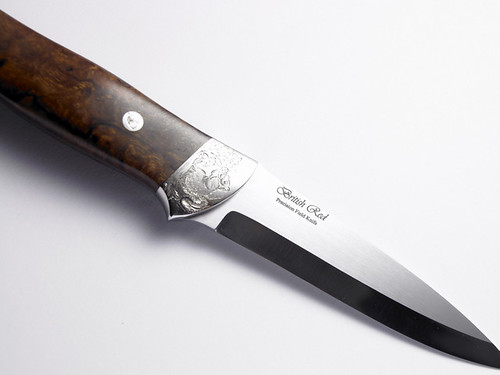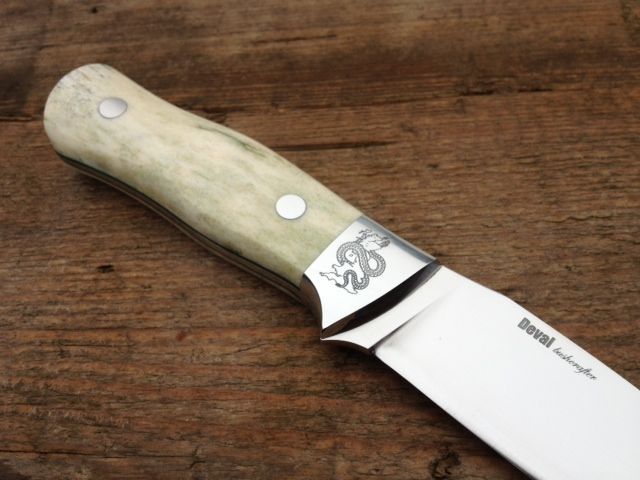I believe that some of you may have seen this knife on Stuart Mitchell's table at Knives UK a few weeks back.
I found myself in the lucky position to try out this new Survival Knife prototype during a recent trip.
Number 476 is made from 5mm RWL34, has a full flat grind and retains its thickness throughout the tang. The blade itself is approximately 10 centimeters long.
Needless to say, it is a beefy and very strong knife. Seen here next to an old style Paramillie for size comparison, the knife has a spearpoint configuration and two large lashing tubes in the handle.
The balance point is right at the forward lashing hole.

The handle itself has a high visibility layer of orange G10 sandwiched between the tang and a rough black canvas micarta scale. The big flared "pommel" lets you grip the knife with your thumb and forefinger, so that the entire knife can be used with extended leverage. The pommel also makes for a very comfortable thumb rest in reverse grip.
The micarta has lots of texture and is grippy even when wet. The interior diameter of the lashing tubes is 7,5mm.

This is helpful when lashing the knife to a pole. Standard sized paracord can be doubled up and slipped comfortably through the tubes to create loops.
Slide your pole through the loops, tighten them and you have a very solid spear point. The choil and the flared pommel prevent your paracord from moving.
The knife point is in line with the lashing holes, making it all quite stable and well balanced.


This knife has a bolster that was constructed to take a beating. Stu used no less than 5 pins to secure it to the tang. He wanted me to see if it would stand up to some abuse, so I used the top part of the bolster to hammer a variety of metal and stone objects... Hammering (or pounding, whichever word you prefer) with the bolster feels much more natural than hammering with a pommel plate. You get the added benefit of a handle, which aids in aim and downward force. The bolster held up very well, even though it suffered from a bit of pitting and scratching.




The bead blasted finish on the knife suffered a bit from use. In any future versions, I think I would prefer a satin finish.
I found the point of the blade to be the strongest I have seen on a fixed blade knife of these dimensions. The spine retains its thickness for a good 7 centimeters and then tapers slightly to the tip.
I still measured 2mm of steel right behind the spear point. Nonetheless, the point is sharp enough to make small and precise puncture holes in leather and fabrics.
It was also strong enough to drill holes in hardwood without having the slightest worry about damaging the tip.


The prototype was used daily in this heavenly topography. Some of these lakes are accessible only by (float)plane.
Some of our gear and means of transportation needed to ride outside the airplane. I made sure to double check the knots!

This knife is thick and strong. The full flat grind helped its slicing ability but shaving feathersticks will never be its forte.
Nonetheless, these came out reasonably thin and without too much effort.

Put your knife down somewhere on these rocks or near the trees and you will have a difficult time relocating your property in the low sunlight.
The orange G10 really made a big difference and I never once misplaced it. I dropped it in a river once and although the water was a scant 4 inches deep where I lost it, the orange streak made it so much easier to spot between the rocks and the sand.



We argued with our pilot about aerodynamics and float planes. In the end he agreed to transport the boat with the bow facing the slipstream.
In his defence, judging by the speed with which we were ambling over the countryside, it would not have made the slightest difference anyway...

Seafood a plenty. You catch it or you buy it from the local fishermen. The salmon comes in all varieties, and its all good!

I had given some thought to the kydex sheath. A nicely rounded kydex sheath is useful as a digging implement. Another good use is to tape a sewing needle and maybe some fishing hooks or safety pins to the sheath before wrapping a length of paracord around it all. With my failing eyesight I also needed one of those loopy things that help old men thread the line through the needle's eye :|.
A 6 foot length of paracord gives you 7 X 6 foot strands of thread that you can use to repair just about anything. Even if you use up the entire 7 strand core of your paracord, the outer sleeve is still plenty strong for most tasks. You can pick up one of these curved sewing needles at your local supermarket.

Salt water mussels nearer St. Lawrence. The spine of the knife is very angular, making it perfect for scraping firesteels and bark tinder.

This female moose couldn't be bothered by our presence. Magnificent sight to see them up close and personal.
Even though it was trampling through a fishermans trapping area.
I thoroughly enjoyed my time with this excellent knife and hope you enjoyed reading about it.
Thanks to Stu Mitchell for letting me have a go.

http://www.stuartmitchellknives.com
I found myself in the lucky position to try out this new Survival Knife prototype during a recent trip.
Number 476 is made from 5mm RWL34, has a full flat grind and retains its thickness throughout the tang. The blade itself is approximately 10 centimeters long.
Needless to say, it is a beefy and very strong knife. Seen here next to an old style Paramillie for size comparison, the knife has a spearpoint configuration and two large lashing tubes in the handle.
The balance point is right at the forward lashing hole.

The handle itself has a high visibility layer of orange G10 sandwiched between the tang and a rough black canvas micarta scale. The big flared "pommel" lets you grip the knife with your thumb and forefinger, so that the entire knife can be used with extended leverage. The pommel also makes for a very comfortable thumb rest in reverse grip.
The micarta has lots of texture and is grippy even when wet. The interior diameter of the lashing tubes is 7,5mm.

This is helpful when lashing the knife to a pole. Standard sized paracord can be doubled up and slipped comfortably through the tubes to create loops.
Slide your pole through the loops, tighten them and you have a very solid spear point. The choil and the flared pommel prevent your paracord from moving.
The knife point is in line with the lashing holes, making it all quite stable and well balanced.


This knife has a bolster that was constructed to take a beating. Stu used no less than 5 pins to secure it to the tang. He wanted me to see if it would stand up to some abuse, so I used the top part of the bolster to hammer a variety of metal and stone objects... Hammering (or pounding, whichever word you prefer) with the bolster feels much more natural than hammering with a pommel plate. You get the added benefit of a handle, which aids in aim and downward force. The bolster held up very well, even though it suffered from a bit of pitting and scratching.




The bead blasted finish on the knife suffered a bit from use. In any future versions, I think I would prefer a satin finish.
I found the point of the blade to be the strongest I have seen on a fixed blade knife of these dimensions. The spine retains its thickness for a good 7 centimeters and then tapers slightly to the tip.
I still measured 2mm of steel right behind the spear point. Nonetheless, the point is sharp enough to make small and precise puncture holes in leather and fabrics.
It was also strong enough to drill holes in hardwood without having the slightest worry about damaging the tip.


The prototype was used daily in this heavenly topography. Some of these lakes are accessible only by (float)plane.
Some of our gear and means of transportation needed to ride outside the airplane. I made sure to double check the knots!

This knife is thick and strong. The full flat grind helped its slicing ability but shaving feathersticks will never be its forte.
Nonetheless, these came out reasonably thin and without too much effort.

Put your knife down somewhere on these rocks or near the trees and you will have a difficult time relocating your property in the low sunlight.
The orange G10 really made a big difference and I never once misplaced it. I dropped it in a river once and although the water was a scant 4 inches deep where I lost it, the orange streak made it so much easier to spot between the rocks and the sand.



We argued with our pilot about aerodynamics and float planes. In the end he agreed to transport the boat with the bow facing the slipstream.
In his defence, judging by the speed with which we were ambling over the countryside, it would not have made the slightest difference anyway...

Seafood a plenty. You catch it or you buy it from the local fishermen. The salmon comes in all varieties, and its all good!

I had given some thought to the kydex sheath. A nicely rounded kydex sheath is useful as a digging implement. Another good use is to tape a sewing needle and maybe some fishing hooks or safety pins to the sheath before wrapping a length of paracord around it all. With my failing eyesight I also needed one of those loopy things that help old men thread the line through the needle's eye :|.
A 6 foot length of paracord gives you 7 X 6 foot strands of thread that you can use to repair just about anything. Even if you use up the entire 7 strand core of your paracord, the outer sleeve is still plenty strong for most tasks. You can pick up one of these curved sewing needles at your local supermarket.

Salt water mussels nearer St. Lawrence. The spine of the knife is very angular, making it perfect for scraping firesteels and bark tinder.

This female moose couldn't be bothered by our presence. Magnificent sight to see them up close and personal.
Even though it was trampling through a fishermans trapping area.
I thoroughly enjoyed my time with this excellent knife and hope you enjoyed reading about it.
Thanks to Stu Mitchell for letting me have a go.

http://www.stuartmitchellknives.com



